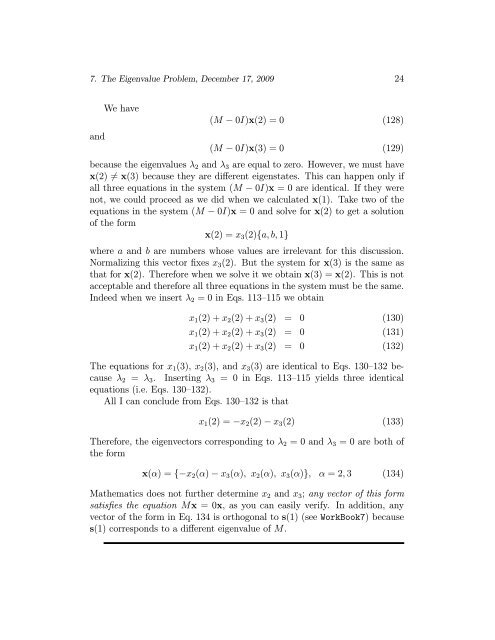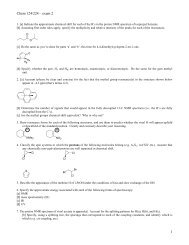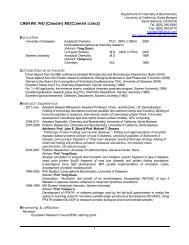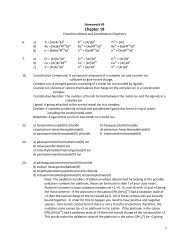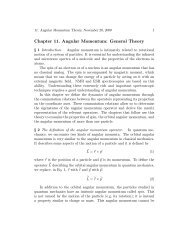Chapter 7. The Eigenvalue Problem
Chapter 7. The Eigenvalue Problem
Chapter 7. The Eigenvalue Problem
You also want an ePaper? Increase the reach of your titles
YUMPU automatically turns print PDFs into web optimized ePapers that Google loves.
<strong>7.</strong> <strong>The</strong> <strong>Eigenvalue</strong> <strong>Problem</strong>, December 17, 2009 24<br />
and<br />
We have<br />
(M − 0I)x(2) = 0 (128)<br />
(M − 0I)x(3) = 0 (129)<br />
because the eigenvalues λ 2 and λ 3 are equal to zero. However, we must have<br />
x(2) = x(3) because they are different eigenstates. This can happen only if<br />
all three equations in the system (M − 0I)x = 0 are identical. If they were<br />
not, we could proceed as we did when we calculated x(1). Taketwoofthe<br />
equations in the system (M − 0I)x = 0 and solve for x(2)togetasolution<br />
of the form<br />
x(2) = x 3 (2){a, b, 1}<br />
where a and b are numbers whose values are irrelevant for this discussion.<br />
Normalizing this vector fixes x 3 (2). But the system for x(3) is the same as<br />
that for x(2). <strong>The</strong>refore when we solve it we obtain x(3) = x(2). This is not<br />
acceptable and therefore all three equations in the system must be the same.<br />
Indeed when we insert λ 2 = 0 in Eqs. 113—115 we obtain<br />
x 1 (2) + x 2 (2) + x 3 (2) = 0 (130)<br />
x 1 (2) + x 2 (2) + x 3 (2) = 0 (131)<br />
x 1 (2) + x 2 (2) + x 3 (2) = 0 (132)<br />
<strong>The</strong> equations for x 1 (3), x 2 (3), and x 3 (3) are identical to Eqs. 130—132 because<br />
λ 2 = λ 3 . Inserting λ 3 = 0 in Eqs. 113—115 yields three identical<br />
equations (i.e. Eqs. 130—132).<br />
All I can conclude from Eqs. 130—132 is that<br />
x 1 (2) = −x 2 (2) − x 3 (2) (133)<br />
<strong>The</strong>refore, the eigenvectors corresponding to λ 2 =0andλ 3 =0arebothof<br />
the form<br />
x(α) ={−x 2 (α) − x 3 (α), x 2 (α), x 3 (α)}, α =2, 3 (134)<br />
Mathematicsdoesnotfurtherdeterminex 2 and x 3 ; any vector of this form<br />
satisfies the equation Mx =0x, as you can easily verify. In addition, any<br />
vector of the form in Eq. 134 is orthogonal to s(1) (see WorkBook7) because<br />
s(1) corresponds to a different eigenvalue of M.


